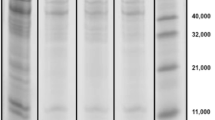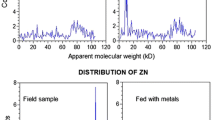Abstract
In response to the environmental pollution by metals such as Cd, Cu, Pb, Ni, and As, special thiol-rich peptides are synthesized in plants and certain fungi. Their general structure is (γ-Glu-Cys)n-R, where R is an amino acid residue (Gly, Ala, Ser, Glu). These peptides are known as plant metallothioneins, class III metallothioneins or γ-EC peptides [1]. Cd and Cu are the metals most frequently bound to plant metallothioneins from different sources and are well characterized by UV spectroscopy due to special absorption of the Cd-S and Cu-S bonds. Another possibility is offered by voltammetric methods which can distinguish between free metal ion and metal ion bound in complexes of different stability. For Cd complexes of γ-EC peptides structural models have been proposed [2] in which each cadmium ion is coordinated by four sulfur atoms. No voltammetric studies have been performed with γ-EC peptides so far. With animal metallothioneins, where tetracoordinated cadmium is present in molecules consisting of 60-62 amino acids, several polarographic and voltammetric studies have been performed. In our first study [3], we worked with rabbit liver metallothionein-2, prepared from rabbits exposed to cadmium salt, and with Cd-MT and apo-MT prepared from rabbit. We compared the voltammetric behavior on several types of carbon electrodes with that on the hanging mercury drop electrode (HMDE); active role of mercury electrode, confirmed also in other papers, can be best demonstrated with cyclic voltammetry (Fig. 1). An extreme reactivity of thiols with mercury is well known and detailed studies on reactions of cystine [4] and cysteine [5] have been performed. Also, it has been demonstrated, that under certain conditions, compact triphenyphosphine oxide films formed at the Hg/solution interface, can block thiol or disulfide adsorption on Hg electrodes [4].
Access this chapter
Tax calculation will be finalised at checkout
Purchases are for personal use only
Preview
Unable to display preview. Download preview PDF.
Similar content being viewed by others
References
Rauser WE (1995) Phytochelatins and Related Peptides. Plant Physiol 109: 1141–1149.
Hayashi Y, Winge DR (1992) (γ - EC)n G Peptides. In: MJ Stillman, CF Shaw III, KT Suzuki (eds): Metallothioneins. VCH, New York, pp. 271–283.
Šestáková I, Miholová D, Vodičková H, Mader P (1995) Electrochemical Behavior of Metallothioneins at Mercury and Carbon Electrodes. Electroanal 7: 237–246.
Heyrovský M, Mader P, Veselá V, Fedurco M (1994) The reactions of cystine at mercury electrodes. J Electroanal Chem 369: 53–70.
Heyrovský M, Mader P, Vavřička S, Veselá V, Fedurco M (1997) The anodic reactions at mercury electrodes due to cysteine. J Electroanal Chem 430: 103–117.
Fedurco M, Sestáková I (1996) Adsorption of Cd, Zn-metallothionein on covered Hg electrodes and its voltammetric determination. Bioelectrochem Bioenerg 40: 223–232.
Munoz A, Rodriguez AR (1995) Electrochemical Behavior of Metallothioneins and Related Molecules. Part III. Metallothionein. Electroanal 7: 674–680.
Munoz A, Rodriguez AR (1995) Electrochemical behavior of metallothioneins and related molecules. PART II: Lys-Cys-Thr-Cys-Cys-Ala thionein fragment [56–61] MT I in the presence of cadmium and/or zinc. Electroanal 7: 670–673.
Nyberg S, Zhou LZ (1995) Polarography as a tool in peptide and protein analysis-studies on metal-chelating substances induced by cadmium in the algae Pheodactylum Tricornutum and the graminae Agrostis Capillaris. Ecotoxicol Environ Safety 32: 147–153.
Štulík K, Pacáková V (1987) Electroanalytical measurements in flowing liquids, Ellis Horwood Ltd, Chichester, England.
Štulík K, Pacákovâ V, Le K, Hennissen B (1988) Amperometric flow detection with a copper working electrode-response mechanism and application to various compounds. Talanta 35: 455–460.
Van den Berg CMG, Househam BC, Riley JP (1988) Determination of cystine and cysteine in seawater using cathodic stripping voltammetry in the presence of Cu (II). J Electroanal Chem 239: 137–148.
Scarano G, Morelli E (1996) Cathodic stripping voltammetric determination of metallothioneins. Electroanal 8: 396–398.
Scarano G, Morelli E (1996) Determination of phytochelatins by cathodic stripping voltammetry in the presence of copper (II). Anal Chim Acta 319: 13–19.
Author information
Authors and Affiliations
Editor information
Editors and Affiliations
Rights and permissions
Copyright information
© 1999 Springer Basel AG
About this chapter
Cite this chapter
Šestáková, I., Mader, P., Vodičková, H., Pacáková, V. (1999). Voltammetric methods in isolation and identification of plant metallothioneins from alga Chlorella . In: Klaassen, C.D. (eds) Metallothionein IV. Advances in Life Sciences. Birkhäuser, Basel. https://doi.org/10.1007/978-3-0348-8847-9_14
Download citation
DOI: https://doi.org/10.1007/978-3-0348-8847-9_14
Publisher Name: Birkhäuser, Basel
Print ISBN: 978-3-0348-9799-0
Online ISBN: 978-3-0348-8847-9
eBook Packages: Springer Book Archive




